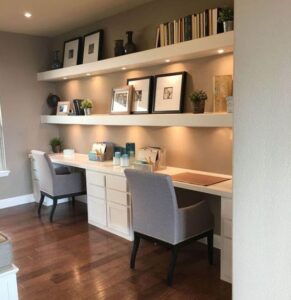 Wow, what a time to be alive! I never thought I’d be writing a design post that was sparked by a pandemic virus, but here we are! Since many of us have had to transition to working from home, we thought it would be a great way to share five tips for your new home office. During this time of “Social Distancing” and COVID-19, a lot of people are struggling from being thrown into working from home without having any place set up. Without structure we can fall into a lot of bad habits causing our work to suffer. Working with your laptop on the couch might be fun for a day, but you will find yourself constantly bogged down by distraction, laziness, and probably meandering into the kitchen way more times than you’d like.
Wow, what a time to be alive! I never thought I’d be writing a design post that was sparked by a pandemic virus, but here we are! Since many of us have had to transition to working from home, we thought it would be a great way to share five tips for your new home office. During this time of “Social Distancing” and COVID-19, a lot of people are struggling from being thrown into working from home without having any place set up. Without structure we can fall into a lot of bad habits causing our work to suffer. Working with your laptop on the couch might be fun for a day, but you will find yourself constantly bogged down by distraction, laziness, and probably meandering into the kitchen way more times than you’d like.
Finding focus and stability in the home office
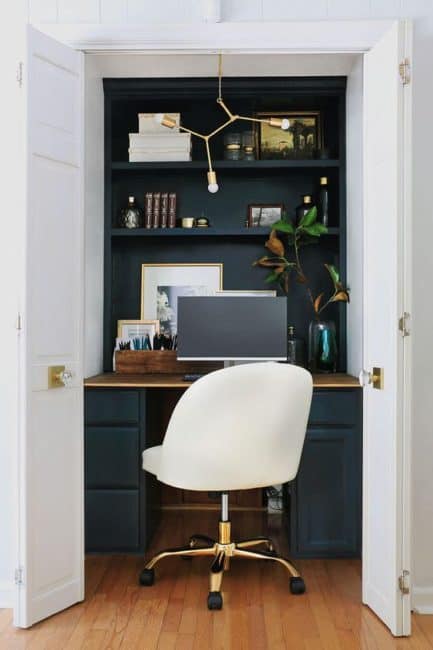
1) Try to find a place you can call your own
I run my business out of my own home, and while I am on the road or jobsites at least 50% of the time, I have learned this lesson the hard way, and moved several times. Your work needs to be in a place where you can focus, but also easily turn off and step away from it. If at all possible, try to keep your home office out of the bedroom, it’s not healthy to have your workspace close to where you are trying to get a good night’s rest. Especially in a time like now when we are all feeling a little extra cooped up, you need to give your brain space away from work, not to be thinking about that email you should have sent last night (and now need to remember to send first thing in the morning) keeping you up all night. Try to keep it kid free if possible. Again, I know a lot of us are making lemonade at this point but try to keep distractions at a minimum. Spare bedrooms or a cornered off section of a finished basement are great places to start.
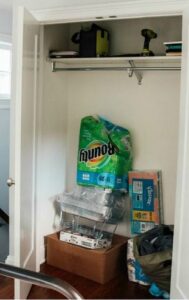
Before
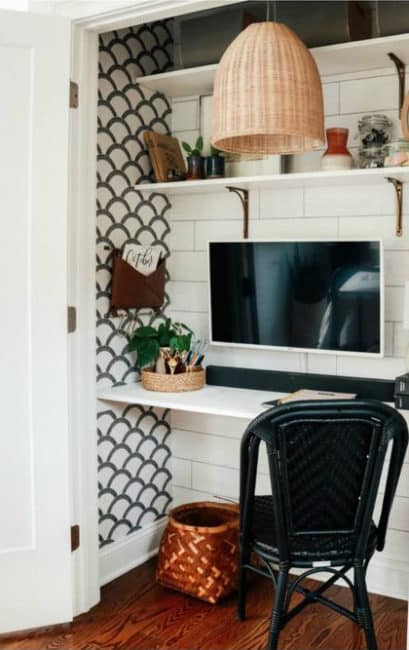
After
Tight on space? Turn a pantry or closet into a mini office. I once worked on a large kitchen remodel where we added lots of pantry storage space into the kitchen, when the client no longer needed to use her large hallway closets for pantry storage we knocked out the shelves, ran a countertop across and a few shelves above, and added a fun wallpaper (so it doesn’t feel like you’re stuck inside a closet!) It’s easy to hide the clutter, simply shut the doors when not in use. When you need to work, open the doors and just pull up a chair, or keep a small backless stool tucked inside. This is also a great idea when you need a homework spot for the kids!
Often times we can’t afford to dedicate an entire room to an office. One easy way to create a generous work surface for one, two or more people is to install banks of drawers with spaces in between along a wall and then run a long countertop surface along a stretch of wall. Get creative with wallpaper or cork board on the wall above, add shelves for books or art, and you’ve got a great place for not only parents to do work, but for kids to do homework!
2) Keep it clutter free
Anyone else a victim of desk piling? As much as I am a proponent of the digital age and being as paperless as possible, many of us need to write things down, or have printed documents so we can focus between the paper and what we’re doing on the screen. I’m personally a BIG list maker, and while I have a plethora of random lists on an app on my phone, I like to start my day with a written to do list and the satisfaction of physically crossing it off. Sometimes these are scattered on post it notes, or on full sized pages if they are for the week or month. Things can get lost in the shuffle, so find a way of organizing yourself that is as EFFORTLESS as possible, so you will actually stick to the routine.
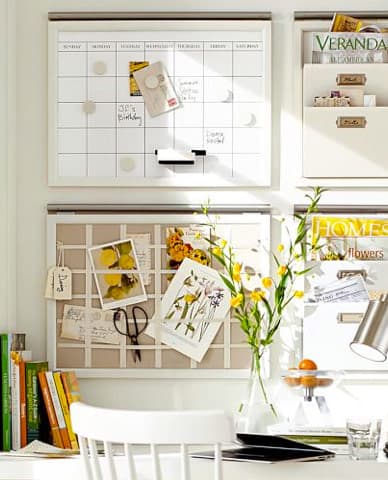
That might mean putting up a white board you can write your lists on to keep you on track and easily glance at from your seat. Perhaps a cork board to pin up other important reminders, visuals etc. Find a simple way to organize any desk clutter with drawers, or file folders. The less visual clutter, the more you can focus.
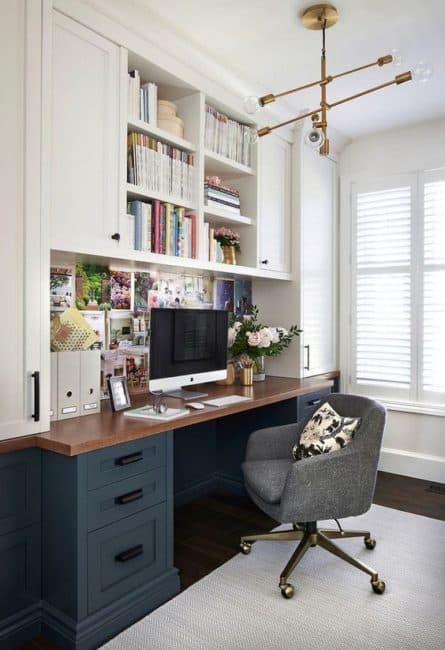
A white board or corkboard behind the desk keeps visual inspiration or reminders close by, without cluttering the work surface.
As more people shift towards working remotely part or full time and we enter the new age of “telecommuting,” here’s another reason why keeping a clutter free workspace is so important. It helps us be seen more clearly during video calls, and will keep people focused on you and your message during the meeting. Not to mention giving a good impression of structure and success to clients, bosses and anyone else. If you’re a small business owner and this is how you do a lot of your work, you may want to take special care to consider what’s in the frame behind you during video calls. If you’re meeting prospective clients or partners you might not want bare drab walls behind you. Reinforce the ideas of success or being an established business with signage, or some nice looking books of shelves in your backdrop.
3) Let it be somewhere you WANT to be!
Let’s be honest, if your “home office” feels sterile or like you’re locked in a cage, you’re going to find excuses to not go in there. Put some things that make you happy in that space. For me, that means having a homey antique desk lamp, an essential oil diffuser, a plant, and a bed for my dog next to my desk. Plants (and pets!) help make a space feel more calming, and add a little life to an otherwise cold space.
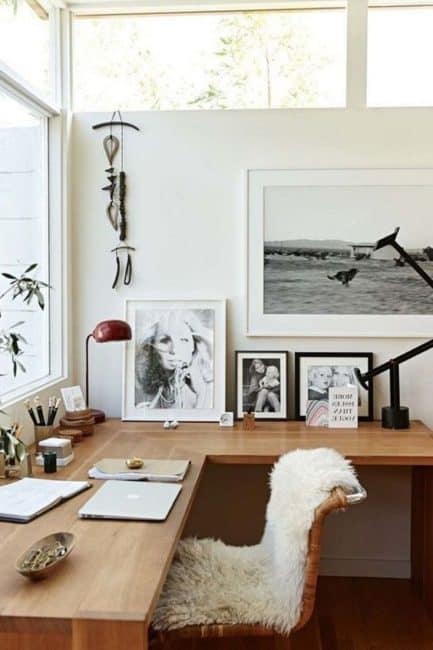
Maybe for you it means photos of places you’ve traveled or loved ones, a cozy rug, a reading chair to curl up in for phone calls or reviewing documents when you need space away from the desk. Natural light is also essential for mood! Even if you don’t have spectacular views, having a window to look at can help you feel less cooped up in your mind. If you are working in a basement, try to find a place that has at a minimum a small window to let some natural light in, but if you’re able to view out of it that’s even better.
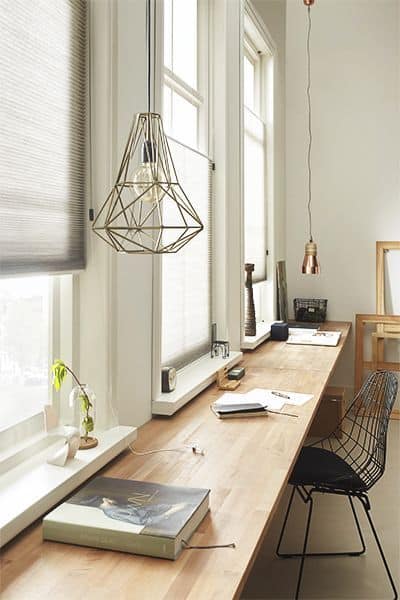
Lots of windows provide natural light, and a spacious wood desktop makes objects easily stand out and gives space to work.
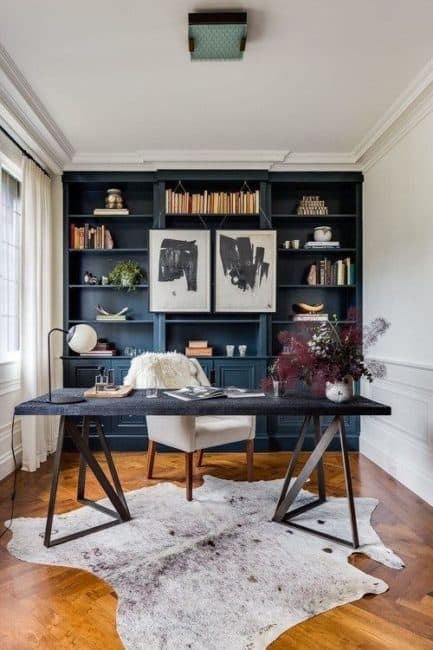
A cowhide rug, painted built ins, artwork and interesting writing table add depth and interest, and windows flood the space with natural light.
4) If it’s not a permanent set up, use pieces that can transition
If you’re not working from home full time, either long term temporary, or part time, you might want pieces that can multifunction. If you’re working in a spare bedroom, a pull out sofa can be great when you need to take a long phone call, but then pull out when you have guests. Or find convertible furniture that can help meet your needs. Resource Furniture has taken the Murphy Bed to the next level with convertible wall beds and desks. Custom built-in furniture can allow you to take this to new heights allowing you to match existing wood work, colors, or more fully build out a wall. Consult with a designer and a skilled woodworker to help you find the right kinds of layouts, hardware, and measurements to make a highly functional dual use space. There are multitudes of different hardware companies with tons of different applications that can do things you’d never imagine. I highly recommend asking an expert to help you navigate these details and to help you build something that is highly specific to you and your space!
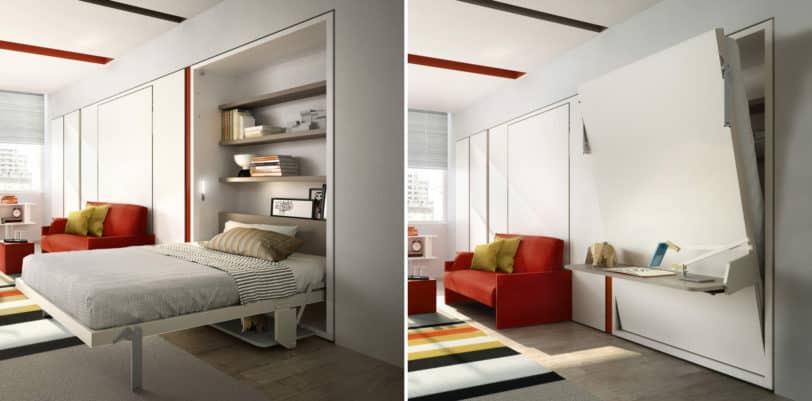
If all you need is a ledge to put a laptop on once in a while, but a bed takes up too much space to have out all the time, this is a great option.
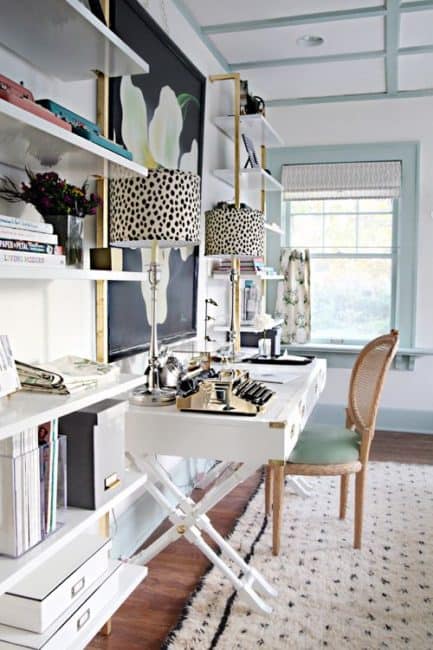
A small writing table can also work as a vanity in a guest bedroom. A futon or sofa bed can add comfort when your space is in “office mode” and transition for when guests come over.
5) Find structure!
Whether you work from home full time, part-time, or have suddenly found yourself working remotely due to the current health crisis, having structure is essential! Setting a schedule, finding a routine, and having a space that is comfortable, efficient and productive will help you find productivity in your work day. The more productive we are, the sooner we can get to enjoying the rest of our homes and families after the work is done! Even though for a many people working from home may be temporary right now, it is very much a reality that more and more corporations are looking into transitioning into part-time or full-time work at home positions. So making sure your workspace feels structured, permanent and not makeshift will all help bring ease of mind.





